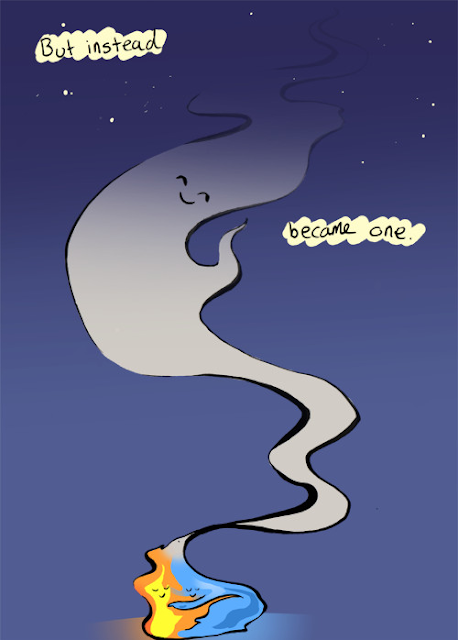I've heard a rumour from Ground Control, Oh no, don't say it's true: By the time I had crawled awkwardly to middle school and had developed a small interest in popular music, another eleven Bowie albums had filled the airwaves from America to Japan. Bowie was larger than life, had changed his persona multiple times, and had impacted the musical world massively before I had shaved for the first time. Beyond owning the 1983 album Let's Dance, and an excellent 1976 compilation album Changesonebowie, I had little interest in the more expansive Bowie. I hadn't learned to look back to the music of my elders for the greats that would influence me so much later in life. My friend Tom Fenselau was wiser and was a bigger fan of Bowie—I was more interested in his step-brother's collection of skate-punk and hard-core. Although I passed quickly through an electronic pop phase in the mid-80s, I quickly turned toward harder fare such as the Sex Pistols, REM, Misfits, Joy Division, Bauhaus, Dead Kennedy's etc. Any chance for discovering a musically stalled out Bowie, or rediscovering his back catalogue, was remote at the time...
They got a message from the Action Man, "I'm happy. Hope you're happy, too...: By the time I was ready to graduate high school I had smoothed off my rougher edges, given up a somewhat self-destructive lifestyle, changed out many of my friends (even found a few really old ones I had ignored for too long), and had begun to open myself to new things, including new music. At the same time this transformation was taking place Rykodisc Records began reissuing the Bowie catalogue starting with Space Oddity (1969) and finishing with Scary Monsters (And Super Creeps) (1980). Major Tom, featured in both "Space Oddity" and "Ashes to Ashes" become the bookends of the Rykodic collection. The headers of this post are the lyrics from "Ashes to Ashes" by the way...
...I've loved. All I've needed: love. Sordid details following.": Bowie decided to retire the songs featured on the Rykodic releases with the 21 Country 4 Continent Sound+Vision tour in the summer and fall of '90, playing the Merriweather Post Pavilion (my neck of the woods) in July. It was something else. It was a "best of" concert that could have felt tired coming from a rocker who was hitting mid-carrier with little new material in years. It wasn't. The energy was intoxicating; the crowd diverse; the night, perfect. My best friend at the time, Tom O'Neil, and I had been eagerly acquiring all the rereleases, and the concert served as a perfect introduction to the real Bowie, twenty years after the fact. With nearly 20,000 in attendance, I still felt like I was in a small venue, right in the presence of greatness rediscovering himself...
The shrieking of nothing is killing me, Just pictures of Jap girls in synthesis: I maintained my love of Bowie from that point on, reveling in each new phase of his ever-changing career. I smiled when he toured with Nine Inch Nails for his Outside (1995) tour and gloried as he experimented with British jungle on Earthling (1997), In the new millennium Bowie returned to his roots and recorded Heathen (2002) which was delightfully refreshing and clean—a return to The Man Who Sold the World sound. I am not ready to review the recent and last Bowie album, Backstar (2016), as Bowie's death is still clouding my objective reaction to it...
And I ain't got no money and I ain't got no hair, But I'm hoping to kick but the planet is glowing: Owing to his ever changing personality and experimentation with dramatically different sounds, it is hard to pick a "best" album or song. I have been toying with what sort of review I might offer to the non-Bowie fan about where to start to discover why his fans are so devoted. I return over and over again to the beginning few years: not Bowie's British beginnings (The Laughing Gnome era), but rather two years later when he first introduced himself to America, changing his name from Davy Jones to David Bowie, and introducing us to Major Tom in the era of the cold-war space race...
Ashes to ashes, funk to funky, We know Major Tom's a junkie, Strung out in heaven's high, Hitting an all-time low...: From 1969 to 1972 Bowie recorded four of his career twenty-seven studio albums. Although Space Oddity (1969) and The Man Who Sold the World (1970) are amazing, I find the transition from Hunky Dory (1971) to The Rise and Fall of Ziggy Stardust and the Spiders from Mars (1972) to be representative of Bowie at his greatest. These albums were the ones that I was most interested in calling up my friend Tom and talking for hours about how amazing each track was. We were so excited to be hearing this stuff from our infancy. I offer two clips below, the first, "Life on Mars" from Hunky Dory: Surreal, kooky, and wonderful—one of my favorite Bowie songs. The second clip is the album opener "Five Years" from Ziggy Stardust. One of the best album starts in my collection, I think. Enjoy...
RIP David Robert Jones




















